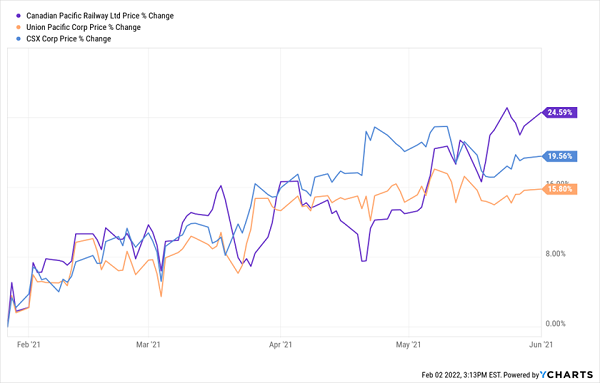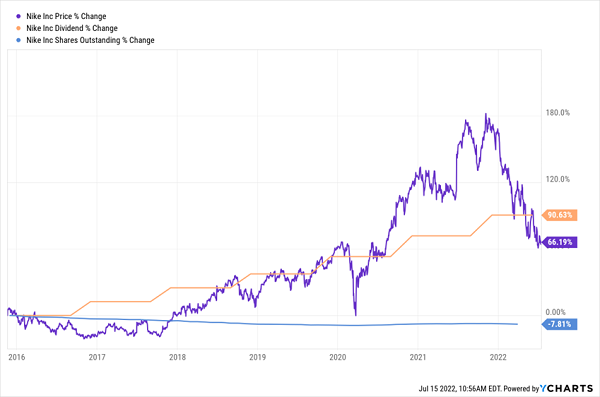Buying into companies that split their stocks tilts the odds sharply in your favor—and buying a “splitter” that grows its payout will help you do even better.
Today we’re going to look at how you can “front run” the next dividend split for fast share-price (and dividend!) growth.
“But wait,” you’re probably thinking. “Aren’t share splits meaningless when it comes to the stock’s overall value?”
True! Let’s look at the case of Amazon.com (AMZN), which performed a share split last month. After the close of trading on Friday, June 3, the company divided each of its shares (which closed at $2,447 that day) into 20 pieces, so the stock opened at $124.79 on Monday, June 6.
Your overall holding would’ve remained the same (though seeing your share price suddenly shrivel like that can cause heart palpitations when you open your account in the morning).
But even though stock splits should have little effect, stocks nonetheless do tend to bounce after a split. And when we add another driver of upside—a dividend that’s not only growing but accelerating—we can get a true growth machine. (This, by the way, is why we can’t recommend Amazon now; we’re dividend investors first and foremost, and as you likely know, Amazon yields exactly 0%.)
How Dividend Growth and Share Splits Delivered a Fast 61% Return
In fact, members of my Hidden Yields dividend-growth service have benefited from this setup—and it helped them walk away with a fast 61% return! It came via our holding in Canadian Pacific Railway (CP), which shows us the power of splits to immediately move share prices.
When CP announced it would split its stock 5-for-1 on January 27, 2021, we grabbed an immediate share-price pop, and CP ran out to a consistent lead over rivals CSX Corp. (CSX) and Union Pacific (UNP) until well after the split happened, on May 14 of that year:
CP Splits, Rolls Ahead of the Pack

CP turned out to be a great buy for us, handing us that 61% return (including a 14.5% dividend hike, in Canadian currency) from the time we bought on April 14, 2020, to our sale date on December 21, 2021.
Share Splits Are About More Than Price
We’ll get into the dividend-growth side of our strategy in a moment. First, let’s look at what the heck is going on with these share splits—and why smart folks see them as a cue to buy.
- Management has confidence—and wants you to know it. Don’t be surprised if more good news follows the announcement of a split, like a big dividend hike or maybe a spinoff.
- Splits make a stock feel “cheaper,” even though we all know a stock’s price doesn’t really matter—at best it’s half the equation and must be held up against earnings, sales, cash flow or other metrics to tell us anything meaningful about a company’s value.
There are lots of reasons why folks get hung up on price. For example, if you’ve been investing for a while, you might still think of buying shares in “round lots”—and a lot of 100 was the smallest you could buy years ago (even though you can buy any number now, and even fractions of shares with some brokerages).
Splits also open the door to smaller investors. The best example here is Berkshire Hathaway (BRK.A) class A shares, for which you’ll pay $418,000 as I write this! That’s a turnoff for most regular folks, who couldn’t afford a single share.
But there’s a psychological game going on here, as well, as even stocks like homebuilder NVR Inc. (NVR), which boasts a $4,395 share price, may also make first-level investors feel like they’re not getting good “value,” as they’ll have to put out $9,000 to buy just two shares.
Meantime, your $9,000 gets you 310 shares of the aforementioned CSX Corp., which is a serial splitter, with five stock splits over its history that have made it one of the “cheapest” stocks in the S&P 500, at $29.
Our Split-Driven Dividend Strategy in Action
As I said above, share splits are only part one of our strategy here: the real key is to look for companies that not only have “high” share prices but also grow their dividends (as we did with CP).
Holding potential splitters like these can really pay off. Consider the case of Nike (NKE), which announced a 2-for-1 stock split, a 14% dividend hike and a $12-billion share-repurchase program (another strong upside driver) all in one go back on November 19, 2015.
The stock immediately popped 4% on the news, then proceeded to ride higher as the company’s “Dividend Magnet”—the reliable pattern of dividends pacing share prices higher as they rise—went to work, pulling the shares up with each hike, as you can see below.
Share Split Is the “Starting Pistol” for Nike’s Payout-Powered Gains

Meanwhile, the buyback (shown by a drop in the number of shares outstanding in the blue line above) has magnified Nike’s earnings per share over the years, which also has a positive effect on the share price, giving the payout an assist as it pulls the stock higher.
All of this makes my share-split strategy easy to put to work. Simply look for a stock with a “high” share price and a dividend that’s not only growing but accelerating.
You’ll give yourself an even better shot at a split-driven price pop if your stock also buys back shares and has a history of previous splits. Nike, for example, had split its stock six times prior to its 2015 split—in 2012, 2007, 1996, 1995, 1990 and 1983.
Beware of “Reverse Share Splits”
Before we sign off on splits, a word of warning about “reverse splits”—this is when a stock has fallen in price, and management moves to cobble together its battered shares to make them feel like they have value.
It is what it sounds like—an attempt to bolster the share price without actually increasing earnings and growing dividends. Fortunately, by investing in dividend payers, you can sidestep this problem, as share consolidations are usually carried out by non-payers, such as penny mines, cannabis stocks and speculative pharma and tech plays.
— Brett Owens
Go Beyond Stock Splits With These 7 Urgent “Recession-Resistant” Buys [sponsor]
I’ve zeroed in on 7 other dividend stocks with the strong payout growth, rising earnings and buybacks needed to weather this market storm—and soar when we (finally!) reach the other side.
I’m forecasting 15%+ yearly gains, on average, from these 7 stout dividend growers over the long haul, as their sharply rising payouts pull their share prices higher.
I’ve created an exclusive Investor Report that gives you all of my research on these 7 reliable buys. Your copy is waiting for you. Click here and I’ll show you how to get your hands on it, and I’ll give you my complete “recession-resistant” dividend-growth strategy, too.
Source: Contrarian Outlook
